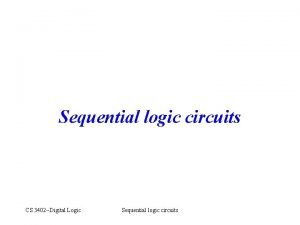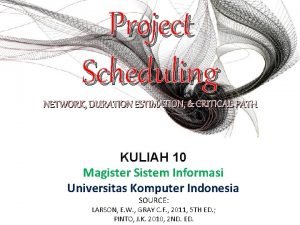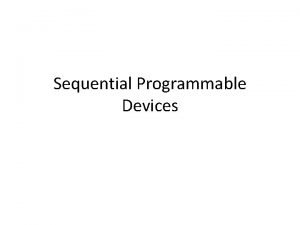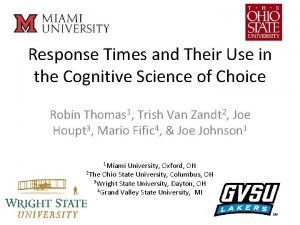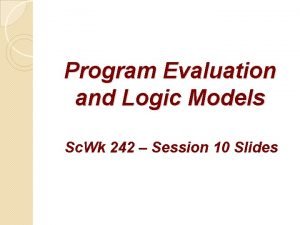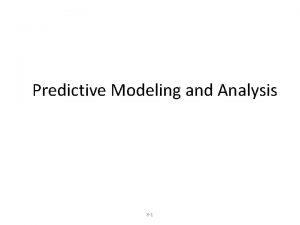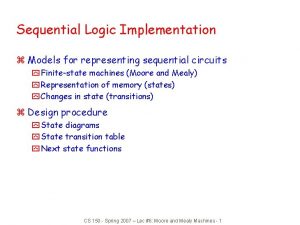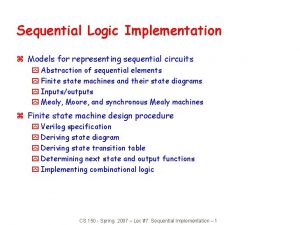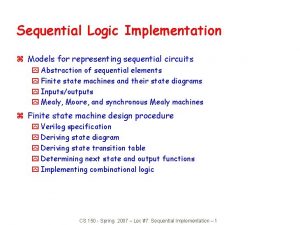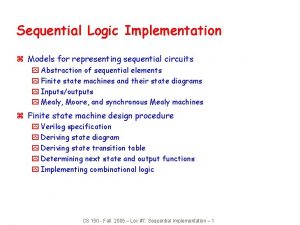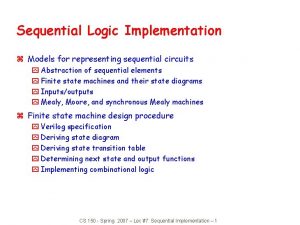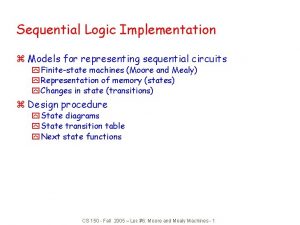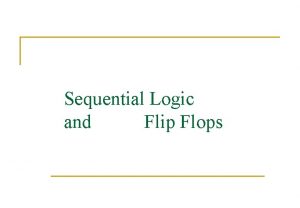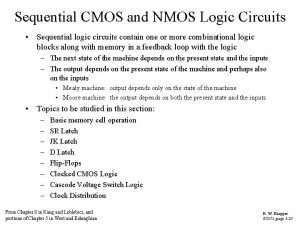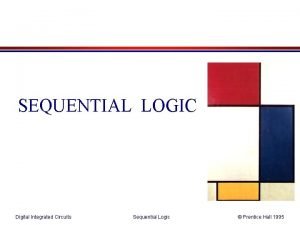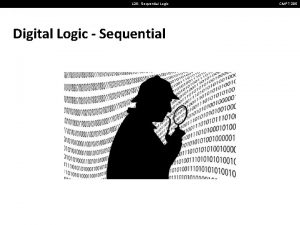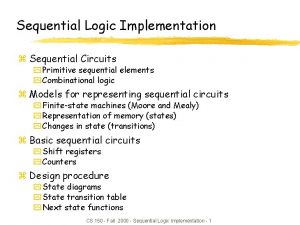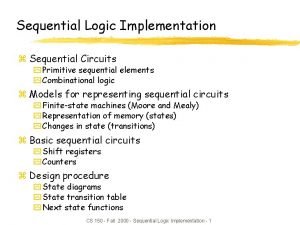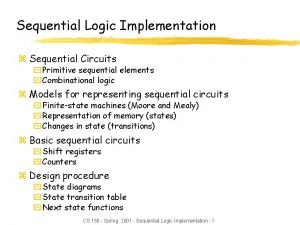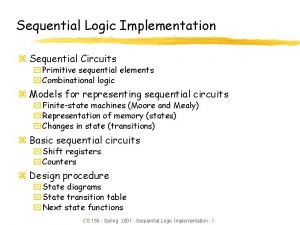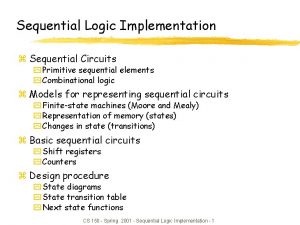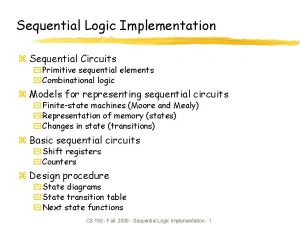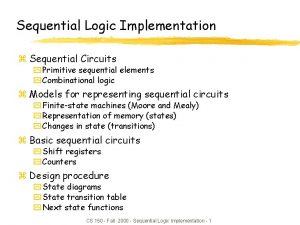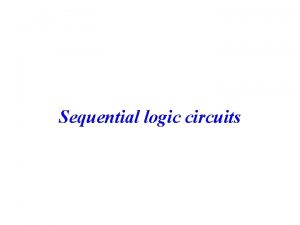Sequential Logic Implementation z Models for representing sequential









![Moore Verilog FSM (cont’d) always @(in or state) case (state) zero [0] zero: begin Moore Verilog FSM (cont’d) always @(in or state) case (state) zero [0] zero: begin](https://slidetodoc.com/presentation_image_h/aa85564ec84c9043468cd46e525ceeed/image-10.jpg)






















- Slides: 32

Sequential Logic Implementation z Models for representing sequential circuits y Abstraction of sequential elements y Finite state machines and their state diagrams y Inputs/outputs y Mealy, Moore, and synchronous Mealy machines z Finite state machine design procedure y Verilog specification y Deriving state diagram y Deriving state transition table y Determining next state and output functions y Implementing combinational logic CS 150 - Fall 2005 – Lec #7: Sequential Implementation – 1

Mealy vs. Moore Machines z Moore: outputs depend on current state only z Mealy: outputs depend on current state and inputs z Ant brain is a Moore Machine y Output does not react immediately to input change z We could have specified a Mealy FSM y Outputs have immediate reaction to inputs y As inputs change, so does next state, doesn’t commit until clocking event L’ R / TL, F L / TL A react right away to leaving the wall L’ R’ / TR, F CS 150 - Fall 2005 – Lec #7: Sequential Implementation – 2

Specifying Outputs for a Moore Machine z Output is only function of state y Specify in state bubble in state diagram y Example: sequence detector for 01 or 10 0 1 B/0 D/1 0 reset 0 1 A/0 0 1 1 C/0 1 0 E/1 reset 1 0 0 0 0 0 input – 0 1 0 1 0 1 current state – A A B B C C D D E E CS 150 - Fall 2005 – Lec #7: Sequential Implementation – 3 next state A B C B D E C B D output 0 0 0 1 1

Specifying Outputs for a Mealy Machine z Output is function of state and inputs y Specify output on transition arc between states y Example: sequence detector for 01 or 10 0/0 B 0/0 reset/0 0/1 A 1/1 1/0 reset 1 0 0 0 input – 0 1 0 1 current state – A A B B C C C 1/0 CS 150 - Fall 2005 – Lec #7: Sequential Implementation – 4 next state A B C B C output 0 0 1 1 0

Comparison of Mealy and Moore Machines z Mealy Machines tend to have less states y Different outputs on arcs (n^2) rather than states (n) z Moore Machines are safer to use y Outputs change at clock edge (always one cycle later) y In Mealy machines, input change can cause output change as soon as logic is done – a big problem when two machines are interconnected – asynchronous feedback z Mealy Machines react faster to inputs y React in same cycle – don't need to wait for clock y In Moore machines, more logic may be necessary to decode state into outputs – more gate delays after inputs logic for Next state. State feedback Logic inputs Combinational reg Logic outputs for Combinational for outputs logic for outputs Next State state feedback CS 150 - Fall 2005 – Lec #7: Sequential Implementation – 5 outputs reg

Mealy and Moore Examples z Recognize A, B = 0, 1 y Mealy or Moore? CS 150 - Fall 2005 – Lec #7: Sequential Implementation – 6

Mealy and Moore Examples (cont’d) z Recognize A, B = 1, 0 then 0, 1 y Mealy or Moore? CS 150 - Fall 2005 – Lec #7: Sequential Implementation – 7

Registered Mealy Machine (Really Moore) z Synchronous (or registered) Mealy Machine y Registered state AND outputs y Avoids ‘glitchy’ outputs y Easy to implement in programmable logic z Moore Machine with no output decoding y Outputs computed on transition to next state rather than after entering y View outputs as expanded state vector Inputs output logic next state logic Current State CS 150 - Fall 2005 – Lec #7: Sequential Implementation – 8 Outputs

Verilog FSM - Reduce 1 s Example z Change the first 1 to 0 in each string of 1’s y Example Moore machine implementation zero [0] 1 0 // State assignment parameter zero = 0, one 1 = 1, two 1 s = 2; module reduce (out, clk, reset, in); output out; input clk, reset, in; reg out; reg [1: 0] state; // state register reg [1: 0] next_state; 0 CS 150 - Fall 2005 – Lec #7: Sequential Implementation – 9 0 one 1 [0] 1 two 1 s [1] 1
![Moore Verilog FSM contd always in or state case state zero 0 zero begin Moore Verilog FSM (cont’d) always @(in or state) case (state) zero [0] zero: begin](https://slidetodoc.com/presentation_image_h/aa85564ec84c9043468cd46e525ceeed/image-10.jpg)
Moore Verilog FSM (cont’d) always @(in or state) case (state) zero [0] zero: begin // last input was a zero out = 0; if (in) next_state = one 1; else next_state = zero; end one 1: begin // we've seen one 1 out = 0; if (in) next_state = two 1 s; else next_state = zero; end two 1 s: begin // we've seen at least 2 ones out = 1; if (in) next_state = two 1 s; else next_state = zero; end default: begin // in case we reach a bad state out = 0; next_state = zero; endcase 1 0 0 0 one 1 [0] 1 1 two 1 s [1] include all signals that are input to state and output equations CS 150 - Fall 2005 – Lec #7: Sequential Implementation – 10

Moore Verilog FSM (cont’d) // Implement the state register always @(posedge clk) if (reset) state <= zero; else state <= next_state; zero [0] 1 endmodule 0 0 one 1 [0] 1 two 1 s [1] CS 150 - Fall 2005 – Lec #7: Sequential Implementation – 11 0 1

Mealy Verilog FSM for Reduce-1 s Example module reduce (clk, reset, in, out); input clk, reset, in; output out; reg state; // state register reg next_state; parameter zero = 0, one = 1; always @(in or state) case (state) zero: begin // last input was a zero if (in) next_state = one; else next_state = zero; out = 0; end one: // we've seen one 1 if (in) begin next_state = one; out = 1; end else begin next_state = zero; out = 0; endcase 0/0 zero 0/0 always @(posedge clk) if (reset) state <= zero; else state <= next_state; endmodule CS 150 - Fall 2005 – Lec #7: Sequential Implementation – 12 1/0 one 1 1/1

Synchronous Mealy Verilog FSM for Reduce-1 s Example module reduce (clk, reset, in, out); input clk, reset, in; output out; reg state; // state register reg next_state; reg next_out; parameter zero = 0, one = 1; always @(in or state) case (state) zero: begin // last input was a zero if (in) next_state = one; else next_state = zero; next_out = 0; end one: // we've seen one 1 if (in) begin next_state = one; next_out = 1; end else begin next_state = zero; next_out = 0; endcase 0/0 zero 0/0 always @(posedge clk) if (reset) begin state <= zero; out <= 0; end else begin state <= next_state; out <= next_out; endmodule CS 150 - Fall 2005 – Lec #7: Sequential Implementation – 13 1/0 one 1 1/1

Announcements z Review Session, Today, 5 -6 PM, 125 Cory Hall z Examination, Wednesday, 1 -2: 30 PM, 125 Cory Hall y Five Quiz-like Questions -- Please Read Them Carefully! They are not intended to be tricky; they should contain all the information you need to answer the question correctly y No calculators or other gadgets are necessary! Don’t bring them! No blue books! All work on the sheets handed out! y Do bring pencil and eraser please! If you like to unstaple the exam pages, then bring a stapler with you! Write your name and student ID on EVERY page in case they get separated -it has happened! y Don’t forget your two-sided 8. 5” x 11” crib sheet! CS 150 - Fall 2005 – Lec #7: Sequential Implementation – 14

Announcements z Examination, Wednesday, 1 -2: 30 PM, 125 Cory Hall y Topics covered through last Wednesday x Combinational logic: design and optimization (K-maps up to and including 6 variables) x Implementation: Simple gates (minimum wires and gates), PLA structures (minimum unique terms), Muxes, Decoders, ROMs, (Simplified) Xilinx CLB x Sequential logic: R-S latches, flip-flops, transparent vs. edge-triggered behavior, master/slave concept x Basic Finite State Machines: Representations (state diagrams, transition tables), Moore vs. Mealy Machines, Shifters, Registers, Counters x Structural and Behavioral Verilog for combinational and sequential logic x Labs 1, 2, 3 x K&B: Chapters 1, 2 (2. 1 -2. 5), 3 (3. 1, 3. 6), 4 (4. 1, 4. 2, 4. 3), 6 (6. 1, 6. 2. 1, 6. 3), 7 (7. 1, 7. 2, 7. 3) CS 150 - Fall 2005 – Lec #7: Sequential Implementation – 15

Example: Vending Machine z Release item after 15 cents are deposited z Single coin slot for dimes, nickels z No change Reset N Coin Sensor D Vending Machine FSM Open Release Mechanism Clock CS 150 - Fall 2005 – Lec #7: Sequential Implementation – 16

Example: Vending Machine (cont’d) z Suitable Abstract Representation y Tabulate typical input sequences: Reset x 3 nickels x nickel, dime x dime, nickel x two dimes S 0 N D y Draw state diagram: x Inputs: N, D, reset x Output: open chute S 1 N y Assumptions: x Assume N and D asserted for one cycle x Each state has a self loop for N = D = 0 (no coin) S 3 S 2 D N S 4 [open] S 5 [open] N S 7 [open] CS 150 - Fall 2005 – Lec #7: Sequential Implementation – 17 D S 6 [open]

Example: Vending Machine (cont’d) z Minimize number of states - reuse states whenever possible present state 0¢ Reset 0¢ 5¢ N D 5¢ 10¢ N D 10¢ N+D 15¢ [open] 15¢ inputs D N 0 0 0 1 1 0 0 0 1 1 – – next state 0¢ 5¢ 10¢ – 5¢ 10¢ 15¢ – 15¢ symbolic state table CS 150 - Fall 2005 – Lec #7: Sequential Implementation – 18 output open 0 0 0 – 1

Example: Vending Machine (cont’d) z Uniquely Encode States present state inputs Q 1 Q 0 D N 0 0 0 1 1 0 1 0 0 0 1 1 1 0 0 1 1 – – next D 1 0 0 1 – 0 1 1 – 1 state D 0 0 1 0 – 1 0 1 – 0 1 1 – 1 output open 0 0 0 – 1 CS 150 - Fall 2005 – Lec #7: Sequential Implementation – 19

Example: Vending Machine (cont’d) z Mapping to Logic Q 1 D 1 0 0 1 1 1 D X X 1 1 Q 0 Q 1 D 0 Q 1 Open 0 0 1 1 N D X X 0 0 1 0 N 0 1 1 1 D X X N 0 0 1 0 Q 0 D 1 = Q 1 + D + Q 0 N D 0 = Q 0’ N + Q 0 N’ + Q 1 N + Q 1 D OPEN = Q 1 Q 0 CS 150 - Fall 2005 – Lec #7: Sequential Implementation – 20

Example: Vending Machine (cont’d) z One-hot Encoding present state Q 3 Q 2 Q 1 Q 0 0 1 0 0 0 1 1 0 0 0 inputs D N 0 0 0 1 1 0 0 0 1 1 - - next state D 3 D 2 D 1 0 0 0 1 0 - - 0 0 1 0 1 0 0 - - 0 1 0 0 - - 1 0 0 output D 0 open 1 0 0 0 0 0 1 D 0 = Q 0 D’ N’ D 1 = Q 0 N + Q 1 D’ N’ D 2 = Q 0 D + Q 1 N + Q 2 D’ N’ D 3 = Q 1 D + Q 2 N + Q 3 OPEN = Q 3 CS 150 - Fall 2005 – Lec #7: Sequential Implementation – 21

Equivalent Mealy and Moore State Diagrams z Moore machine y outputs associated with state N’ D’ + Reset 0¢ [0] Mealy machine outputs associated with transitions 0¢ N’ D’ N D N’ D’/0 N/0 5¢ [0] N’ D’ D/0 N D (N’ D’ + Reset)/0 Reset/0 5¢ N’ D’/0 10¢ N’ D’/0 15¢ Reset’/1 N/0 10¢ [0] N’ D’ N+D D/1 N+D/1 15¢ [1] Reset’ CS 150 - Fall 2005 – Lec #7: Sequential Implementation – 22

Moore Verilog FSM for Vending Machine module vending (open, Clk, Reset, N, D); input Clk, Reset, N, D; output open; reg state; // state register reg next_state; parameter zero = 0, five = 1, ten = 2, fifteen = 3; always @(N or D or state) case (state) zero: begin if (D) next_state else if (N) next_state else next_state open = 0; end … fifteen: begin if (!Reset) next_state else next_state open = 1; endcase N’ D’ + Reset 0¢ [0] N’ D’ N = five; = ten; = zero; D 5¢ [0] N’ D’ N = fifteen; = zero; always @(posedge clk) if (Reset || (!N && !D)) state <= zero; else state <= next_state; endmodule CS 150 - Fall 2005 – Lec #7: Sequential Implementation – 23 D 10¢ [0] N’ D’ N+D 15¢ [1] Reset’

Mealy Verilog FSM for Vending Machine module vending (open, Clk, Reset, N, D); input Clk, Reset, N, D; output open; reg state; // state register reg next_state; reg next_open; parameter zero = 0, five = 1, ten = 2, fifteen = 3; always @(N or D or state) case (state) zero: begin if (D) begin next_state = ten; next_open = 0; end else if (N) begin next_state = five; next_open = 0; end else begin next_state = zero; next_open = 0; end … endcase (N’ D’ + Reset)/0 Reset/0 0¢ N’ D’/0 N/0 D/0 5¢ N’ D’/0 10¢ N’ D’/0 15¢ Reset’/1 N/0 D/1 N+D/1 always @(posedge clk) if (Reset || (!N && !D)) begin state <= zero; open <= 0; end else begin state <= next_state; open <= next_open; endmodule CS 150 - Fall 2005 – Lec #7: Sequential Implementation – 24

Example: Traffic Light Controller z A busy highway is intersected by a little used farmroad z Detectors C sense the presence of cars waiting on the farmroad y with no car on farmroad, light remain green in highway direction y if vehicle on farmroad, highway lights go from Green to Yellow to Red, allowing the farmroad lights to become green y these stay green only as long as a farmroad car is detected but never longer than a set interval y when these are met, farm lights transition from Green to Yellow to Red, allowing highway to return to green y even if farmroad vehicles are waiting, highway gets at least a set interval as green z Assume you have an interval timer that generates: y a short time pulse (TS) and y a long time pulse (TL), y in response to a set (ST) signal. y TS is to be used for timing yellow lights and TL for green lights CS 150 - Fall 2005 – Lec #7: Sequential Implementation – 25

Example: Traffic Light Controller (cont’d) z Highway/farm road intersection farm road car sensors highway CS 150 - Fall 2005 – Lec #7: Sequential Implementation – 26

Example: Traffic Light Controller (cont’d) z Tabulation of Inputs and Outputs inputs reset C TS TL description place FSM in initial state detect vehicle on the farm road short time interval expired long time interval expired outputs description HG, HY, HR assert green/yellow/red highway lights FG, FY, FR assert green/yellow/red highway lights ST start timing a short or long interval z Tabulation of unique states – some light configurations imply others state S 0 S 1 S 2 S 3 description highway green (farm road red) highway yellow (farm road red) farm road green (highway red) farm road yellow (highway red) CS 150 - Fall 2005 – Lec #7: Sequential Implementation – 27

Example: Traffic Light Controller (cont’d) z State Diagram Reset (TL • C)' S 0 TL • C / ST S 0: HG S 1: HY TS / ST TL+C / ST TS' S 1 S 3 S 2: FG S 3: FY TS / ST TL+C' / ST S 2 (TL+C')' CS 150 - Fall 2005 – Lec #7: Sequential Implementation – 28 TS'

Example: Traffic Light Controller (cont’d) z Generate state table with symbolic states z Consider state assignments Inputs C TL 0 – – 0 1 1 – – 1 0 0 – – 1 – – SA 1: SA 2: SA 3: Present State TS – – – 0 1 HG HG HG HY HY FG FG FG FY FY HG = 0001 Next State HG HG HY HY FG FG FY FY FY HG HY = 01 HY = 10 HY = 0010 FG = 11 FG = 0100 output encoding – similar problem to state assignment (Green = 00, Yellow = 01, Red = 10) Outputs ST H 0 Green 1 Green 0 Yellow 1 Yellow 0 Red 1 Red FY = 10 FY = 11 FY = 1000 CS 150 - Fall 2005 – Lec #7: Sequential Implementation – 29 F Red Red Red Green Yellow (one-hot)

Traffic Light Controller Verilog always @(C or TL or TS or state) case (state) S 0: if (!(TL && C)) begin next_state = S 0; next_ST = 0; else if (TL || C) begin next_state = S 1; next_ST = 1; end … endcase Reset (TL • C)' module traffic (ST, Clk, Reset, C, TL, TS); input Clk, Reset, C, TL, TS; output ST; reg state; reg next_ST; parameter S 0 = 0, S 1 = 1, S 2 = 2, S 3 = 3; S 0 TL • C TS / ST TL+C / ST TS' S 1 S 3 TS / ST always @(posedge Clk) if (Reset) begin state <= S 0; ST <= 0; end else begin state <= next_state; ST <= next_ST; endmodule CS 150 - Fall 2005 – Lec #7: Sequential Implementation – 30 TL+C' / ST S 2 (TL+C')' TS'

Logic for Different State Assignments z SA 1 z SA 2 z SA 3 NS 1 = C • TL' • PS 1 • PS 0 + TS • PS 1' • PS 0 + TS • PS 1 • PS 0' + C' • PS 1 • PS 0 + TL • PS 1 • PS 0 NS 0 = C • TL • PS 1' • PS 0' + C • TL' • PS 1 • PS 0 + PS 1' • PS 0 ST = C • TL • PS 1' • PS 0' + TS • PS 1' • PS 0 + TS • PS 1 • PS 0' + C' • PS 1 • PS 0 + TL • PS 1 • PS 0 H 1 = PS 1 H 0 = PS 1' • PS 0 F 1 = PS 1' F 0 = PS 1 • PS 0' NS 1 = C • TL • PS 1' + TS' • PS 1 + C' • PS 1' • PS 0 NS 0 = TS • PS 1 • PS 0' + PS 1' • PS 0 + TS' • PS 1 • PS 0 ST = C • TL • PS 1' + C' • PS 1' • PS 0 + TS • PS 1 H 1 = PS 0 H 0 = PS 1 • PS 0' F 1 = PS 0' F 0 = PS 1 • PS 0 NS 3 = C' • PS 2 + TL • PS 2 + TS' • PS 3 NS 1 = C • TL • PS 0 + TS' • PS 1 NS 2 = TS • PS 1 + C • TL' • PS 2 NS 0 = C' • PS 0 + TL' • PS 0 + TS • PS 3 ST = C • TL • PS 0 + TS • PS 1 + C' • PS 2 + TL • PS 2 + TS • PS 3 H 1 = PS 3 + PS 2 H 0 = PS 1 F 1 = PS 1 + PS 0 F 0 = PS 3 CS 150 - Fall 2005 – Lec #7: Sequential Implementation – 31

Sequential Logic Implementation Summary z Models for representing sequential circuits y Abstraction of sequential elements y Finite state machines and their state diagrams y Inputs/outputs y Mealy, Moore, and synchronous Mealy machines z Finite state machine design procedure y Verilog specification y Deriving state diagram y Deriving state transition table y Determining next state and output functions y Implementing combinational logic CS 150 - Fall 2005 – Lec #7: Sequential Implementation – 35
 Combinational logic sequential logic 차이
Combinational logic sequential logic 차이 Combinational logic circuit vs sequential
Combinational logic circuit vs sequential Logic chapter three
Logic chapter three Software project wbs example
Software project wbs example Combinational logic sequential logic
Combinational logic sequential logic Aoi digital electronics
Aoi digital electronics Hardware implementation of logic microoperations
Hardware implementation of logic microoperations S r q logic
S r q logic What is project duration
What is project duration What is a nonserual sequential logic in project
What is a nonserual sequential logic in project Combinational logic devices
Combinational logic devices Sequential sampling models
Sequential sampling models First order logic vs propositional logic
First order logic vs propositional logic Tw
Tw First order logic vs propositional logic
First order logic vs propositional logic First order logic vs propositional logic
First order logic vs propositional logic Types of logic models
Types of logic models Types of logic models
Types of logic models Logic driven predictive models
Logic driven predictive models Difference between model and semi modals
Difference between model and semi modals Treserva lathund
Treserva lathund Cks
Cks Läkarutlåtande för livränta
Läkarutlåtande för livränta Påbyggnader för flakfordon
Påbyggnader för flakfordon Tack för att ni lyssnade
Tack för att ni lyssnade Inköpsprocessen steg för steg
Inköpsprocessen steg för steg Egg för emanuel
Egg för emanuel En lathund för arbete med kontinuitetshantering
En lathund för arbete med kontinuitetshantering Atmosfr
Atmosfr Rutin för avvikelsehantering
Rutin för avvikelsehantering Biologiska arvet
Biologiska arvet Myndigheten för delaktighet
Myndigheten för delaktighet Presentera för publik crossboss
Presentera för publik crossboss







